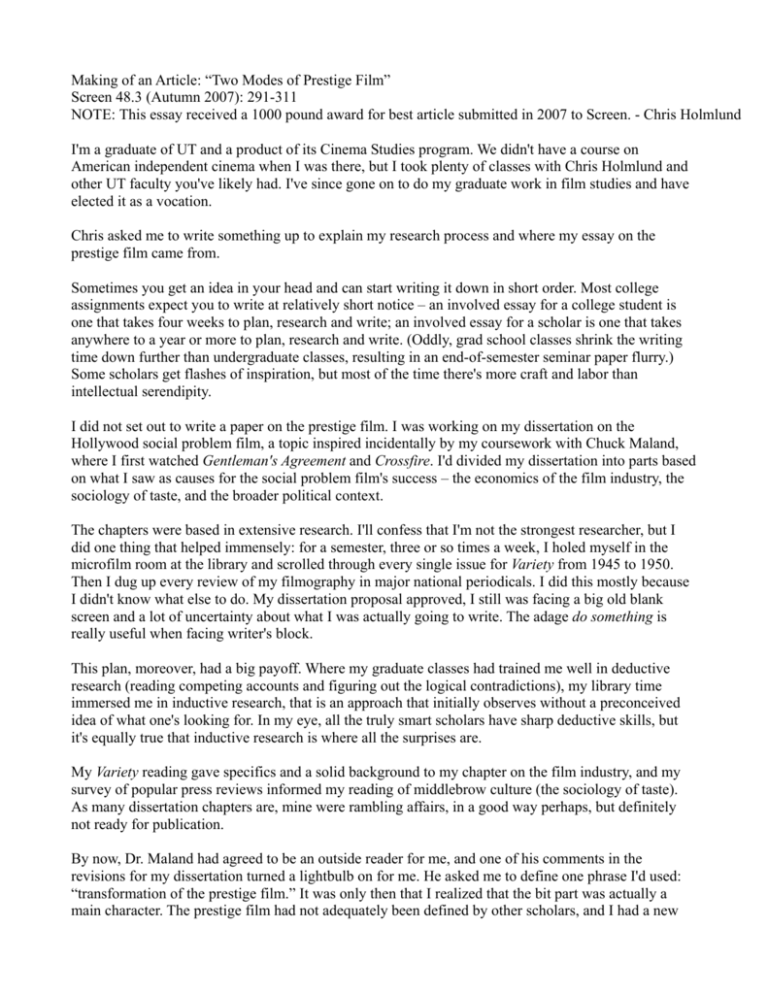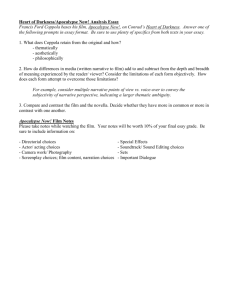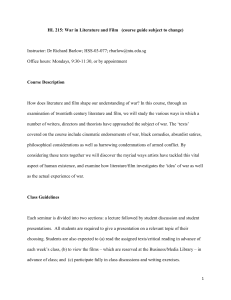Making of an Article: “Two Modes of Prestige Film” Screen 48.3
advertisement

Making of an Article: “Two Modes of Prestige Film” Screen 48.3 (Autumn 2007): 291-311 NOTE: This essay received a 1000 pound award for best article submitted in 2007 to Screen. - Chris Holmlund I'm a graduate of UT and a product of its Cinema Studies program. We didn't have a course on American independent cinema when I was there, but I took plenty of classes with Chris Holmlund and other UT faculty you've likely had. I've since gone on to do my graduate work in film studies and have elected it as a vocation. Chris asked me to write something up to explain my research process and where my essay on the prestige film came from. Sometimes you get an idea in your head and can start writing it down in short order. Most college assignments expect you to write at relatively short notice – an involved essay for a college student is one that takes four weeks to plan, research and write; an involved essay for a scholar is one that takes anywhere to a year or more to plan, research and write. (Oddly, grad school classes shrink the writing time down further than undergraduate classes, resulting in an end-of-semester seminar paper flurry.) Some scholars get flashes of inspiration, but most of the time there's more craft and labor than intellectual serendipity. I did not set out to write a paper on the prestige film. I was working on my dissertation on the Hollywood social problem film, a topic inspired incidentally by my coursework with Chuck Maland, where I first watched Gentleman's Agreement and Crossfire. I'd divided my dissertation into parts based on what I saw as causes for the social problem film's success – the economics of the film industry, the sociology of taste, and the broader political context. The chapters were based in extensive research. I'll confess that I'm not the strongest researcher, but I did one thing that helped immensely: for a semester, three or so times a week, I holed myself in the microfilm room at the library and scrolled through every single issue for Variety from 1945 to 1950. Then I dug up every review of my filmography in major national periodicals. I did this mostly because I didn't know what else to do. My dissertation proposal approved, I still was facing a big old blank screen and a lot of uncertainty about what I was actually going to write. The adage do something is really useful when facing writer's block. This plan, moreover, had a big payoff. Where my graduate classes had trained me well in deductive research (reading competing accounts and figuring out the logical contradictions), my library time immersed me in inductive research, that is an approach that initially observes without a preconceived idea of what one's looking for. In my eye, all the truly smart scholars have sharp deductive skills, but it's equally true that inductive research is where all the surprises are. My Variety reading gave specifics and a solid background to my chapter on the film industry, and my survey of popular press reviews informed my reading of middlebrow culture (the sociology of taste). As many dissertation chapters are, mine were rambling affairs, in a good way perhaps, but definitely not ready for publication. By now, Dr. Maland had agreed to be an outside reader for me, and one of his comments in the revisions for my dissertation turned a lightbulb on for me. He asked me to define one phrase I'd used: “transformation of the prestige film.” It was only then that I realized that the bit part was actually a main character. The prestige film had not adequately been defined by other scholars, and I had a new framework for looking at it. I gave it some more thought, then extracted the parts from my film industry chapter that applied and the parts from my sociology of taste chapter about middlebrow reception. I rewrote the transitions and smoothed the edges. I'd just recently watched both Dodsworth and Marty (watching a wide variety of movies is good inductive research, too), so they were fresh on my mind as I wrote a new intro to tie it all together. The retooled essay was something I could submit to Screen. Other top journals, like Cinema Journal or Quarterly Review of Film and Video, will publish more narrow, specialist historical essays, but Screen has a tendency to prefer essays with a wider applicability to media scholars in other areas. Essentially, my retooled paper was no longer about the 1940s problem film, it was about we understand “serious” cinema (or television for that matter). Screen was an ambitious choice – this was my first journal submission – but I figured I'd aim high. So I polished and proofread and proofread again to clarify my prose, get rid of the typos, and pare down the jargon. I made the paper conform to the journal's guidelines, then mailed it off. And waited. Journal articles go through a review process to make sure they contain accurate information, follow the expected scholarly standards of evidence and argument, and make an important contribution to the field. It's a little involved but mostly takes a while because professors are the ones volunteering to do the work of reviewing, and as you may know they tend to work on their own schedules and in general have plenty on their plate already. After waiting a little over a year later I got a response: the reader reports have some suggestions but are positive. The journal would like to print my essay. Reader reports can be tough and even nasty. I lucked out with reader reports that were critical in constructive ways. I took their advice as well as I could and revised my essay. At this point particularly I crafted every sentence to make sure the language was clear and that concrete nouns and active verbs were making my claims. Two months later, I received proofs to review, then two months again, the essay came out in print. A gratifying end, to be sure. I know I've painted a picture of a lot of work and even more time, but oddly enough, the thing I most value about this essay is how I learned in the process of writing it. It's also a testament that bigger ideas build up out of smaller steps and surprise detours. I would not say the film studies academic path is for everyone, since it requires someone who loves ideas about film as much as she or he loves the films themselves, but I do love both. It's a tremendous luxury to spend my working days thinking, teaching, and writing about these matters.






